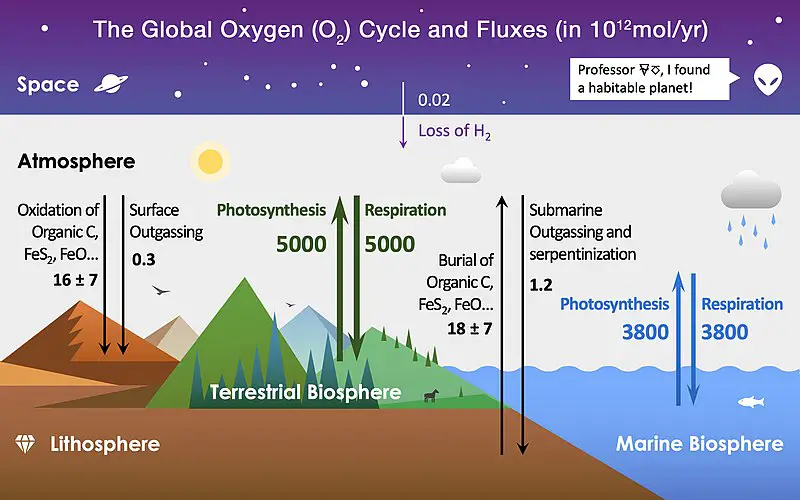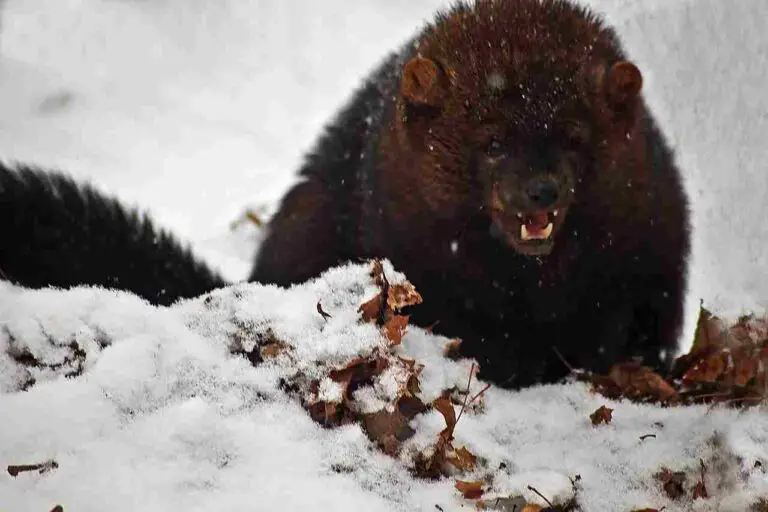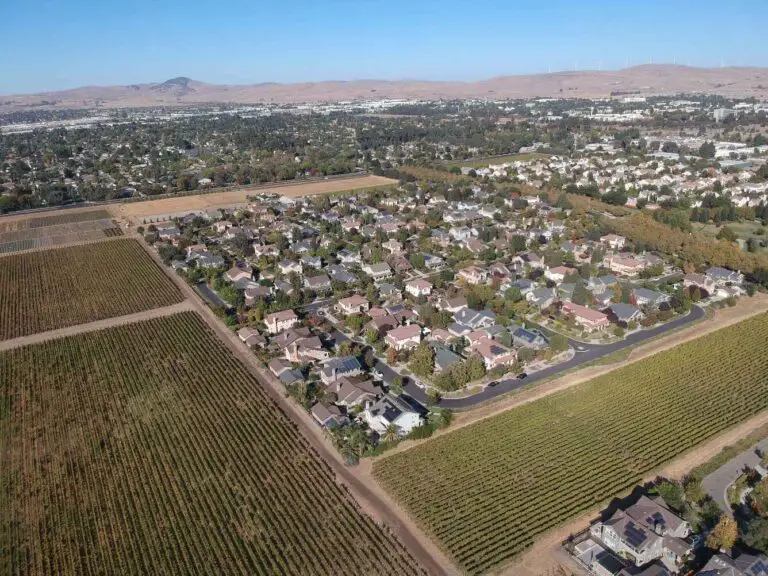3 Steps of Oxygen Cycle Process Explained
The steps of oxygen cycle process are; capture or intake (through respiration), utilization or consumption (through combustion, corrosion, biodegradation), and uptake-and-release (through photosynthesis).
This article discusses the steps of oxygen cycle process, as follows;
1). Oxygen Capture or Intake (as one of the Steps of Oxygen Cycle Process)
Oxygen capture or intake is a pioneer step of the oxygen cycle process.
It represents the interaction between biotic and abiotic factors as living organisms inhale oxygen from the atmosphere for their metabolic activities.
The main source of oxygen to living organisms in the ecosystem is autotrophic photosynthesis; which is the use of solar energy, carbon dioxide and water as raw materials for the manufacture of bioenergy, biomass and oxygen [1].
Oxygen capture or intake, reveals links between oxygen and carbon cycles. This is because the production and intake of oxygen are also part of a typical carbon cycle.
Oxygen production occurs within the same context as carbon sequestration in autotroph-dominated environments (including soil). Intake of oxygen, on the other hand, preceded the release of carbon as a gaseous component of carbon-dioxide (CO2).
The ecologic relationship between autotrophs and heterotrophs covers oxygen capture and intake.
Heterotrophs are responsible for this step in the oxygen cycle process, and their activities lead to the oxygenation of terrestrial and aquatic ecosystems including forests and oceans.
It must be noted that oxygen intake in the geochemical recycling context, is restricted to the act or process of oxygen transfer into a given system from the atmosphere. This is why the term oxygen 'capture' is used alternatively, to indicate its similarity to anthropogenic carbon capture.
As a result, the actual consumption or utilization of oxygen is a different concept that usually succeeds oxygen intake.
Oxygen intake may occur on small or large scales; where large-scale intake can be attributed to macro ecosystems with dominant presence of mammals, reptiles, amphibians and aves; and small-scale intake can be attributed to micro-ecosystems with dominant presence of insects and microbes.
The overall process of oxygen cycling comprises of multiple processes that work collaboratively. In oxygen intake, which is the first step; respiration is the key process (although this is restricted to the inhalation stage of respiration). It may occur in any of various forms, such as pulmonary, cutaneous and branchial respirations, respectively.

2). Utilization or Consumption
The utilization of oxygen in the oxygen cycle, is the second stage after the intake of oxygen.
As the name implies, it involves the usage of captured oxygen for any of various purposes.
Oxygen utilization is mostly restricted to the biosphere, as the demand for oxygen occurs mainly in organic processes and systems.
It can be argued that respiration is not solely a process of oxygen intake; because inhalation of oxygen is shortly followed by exhalation of carbon dioxide.
In-between inhalation and exhalation is a period of oxygen consumption, during which the inhaled oxygen is used up in the cells and tissues of living organisms.
Oxygen utilization in organic tissues and cells is very essential toward survival, metabolism and growth [4].
The rate of oxygen consumption depends on its use; as studies show that strenuous physical activity leads to exponential increase in oxygen usage [3]. This only emphasizes the importance of the consumption/utilization step of the oxygen cycle, toward metabolic processes in organisms.
Cellular oxygen consumption is behind other biological processes that occur in this stage. Perhaps the most important of these is biodegradation.
Microbial biodegradation often proceeds in the presence of sufficient amounts of oxygen. In such cases, aerobic microorganisms use oxygen consumed in their cells to fuel the metabolic activities involved in breaking down an organic substrate, or biomass.
While it has been said that oxygen utilization is dominantly a biotic process, there are some processes of oxygen utilization that have abiotic characteristics.
These generally involve chemical reactions where oxygen plays a key role, but which do not necessarily occur in organic cells.
Two classic examples of such abiotic oxygen-utilization processes are corrosion, and combustion. Each of these reaction processes lead to oxidization and the formation of new products as oxygen is used up by the reactants.
Such products include ferrous oxide, carbon dioxide, and thermal energy.

3). Uptake-and-Release (as one of the Steps of Oxygen Cycle Process)
Uptake-and-release is a multi-process concept which can also be regarded as the final step of the oxygen cycle process.
Oxygen is used up and released as a component of oxygenated chemical compounds. Examples of these compounds are water (H2O) and carbon dioxide (CO2), produced in biodegradation, respiration (exhalation stage) and combustion.
Ferrous oxide and hydrated iron Fe(OH)2 from corrosion are other examples of oxygenated compounds that signify oxygen release after utilization. Organic waste from metabolic processes is also an oxygenated product that breaks down to yield inorganic oxygenated compounds that are held in soil and water as extractable nutrients.
The release of oxygen in its native form in the oxygen cycle, can occur only after it has been taken up and extracted from an oxygenated compound. This is what is referred to oxygen uptake.
Primarily, oxygen uptake occurs through photosynthesis. Here, autotrophic organisms like algae and vascular plants ingest oxygenated compounds as nutrients in soil and aquatic ecosystems (including freshwater and marine biomes).
Water itself is a prominent oxygenated compound that is taken up by autotrophs and used in the process of photosynthesis. After photosynthesis has occurred, the oxygen is released in its native, gaseous form, into the atmosphere [2].
Oxygen uptake and release are mutually-dependent processes that signify a terminal point in one oxygen cycle, and the inception of another.
The details of these processes depend on the type of oxygen cycle involved.
There are two types of oxygen cycles, which are; micro- and macro-oxygen cycles respectively.
In the micro oxygen cycle, all steps and processes occur on a relatively small scale; and the dominant organisms are microscopic in their dimensions.
Autotrophs in this type of oxygen cycle are mostly microalgae; while those in the macro oxygen cycle are mostly vascular plants.
Lastly, it must be noted that the processes of a natural, biogeochemical oxygen cycle do not always include manmade processes like artificial photosynthesis and combustion. Rather, only natural oxygenic processes like photosynthesis are included, as shown in the illustration below;

Conclusion
The steps of oxygen cycle process are;
1. Oxygen Capture or Intake
2. Utilization or Consumption
3. Uptake-and-Release
References
1). Barber, J.; Tran, P. D. (2013). "From natural to artificial photosynthesis." J R Soc Interface. 2013 Jan 30;10(81):20120984. Available at: https://doi.org/10.1098/rsif.2012.0984. (Accessed 3 May 2023).
2). Junge, W. (2019). "Oxygenic photosynthesis: History, status and perspective." Quarterly Reviews of Biophysics 52. Available at: https://doi.org/10.1017/S0033583518000112. (Accessed 3 May 2023).
3). Radak, Z.; Zhao, Z.; Koltai, E.; Ohno, H.; Atalay, M. (2013). "Oxygen consumption and usage during physical exercise: the balance between oxidative stress and ROS-dependent adaptive signaling." Antioxid Redox Signal. 2013 Apr 1;18(10):1208-46. Available at: https://doi.org/10.1089/ars.2011.4498. (Accessed 3 May 2023).
4). Wagner, B. A.; Venkataraman, S.; Buettner, G. R. (2011). "The rate of oxygen utilization by cells." Free Radic Biol Med. 2011 Aug 1;51(3):700-12. Available at: https://doi.org/10.1016/j.freeradbiomed.2011.05.024. (Accessed 3 May 2023).



